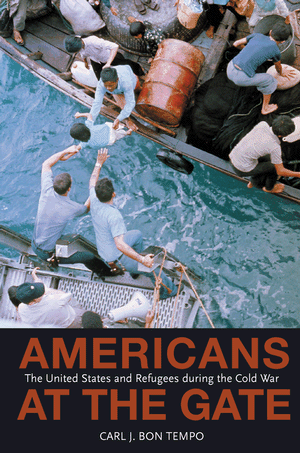 d for the Law and Politics Book Review by Samuel S. Stanton, Jr., Associate Professor of Political Science, Department of Political Science, Grove City College. Stanton writes:
d for the Law and Politics Book Review by Samuel S. Stanton, Jr., Associate Professor of Political Science, Department of Political Science, Grove City College. Stanton writes: Carl J. Bon Tempo’s work is designed to examine the intermingled domestic and international contexts of US refugee policy during the Cold War and into the post Cold War eras. This design is carried out by examining the existing state of US refugee policy entering the Cold War and highlighting different periods of the Cold War era. Included in this work are three distinct case studies regarding refugees admitted into the US; Hungarians in the 1950s, Cubans in the 1960s, and Indochinese in the 1970s and 1980s. Bon Tempo carefully considers domestic sources of policy and international political realities that have been important to the shaping of US refugee policy....
Bon Tempo presents a lengthy exposition of President Truman’s 1946 proposal to accept European refugees outside of the normal quotas leading to the 1948 Displaced Persons Act. Particularly important for students and researchers to note is that the acceptance was not without limiting criteria – often based on political decisions about the quality of the regime from which the refugees were fleeing. The Displaced Persons Act of 1948 led to the entry of over 400,000 European refugees into the US prior to the closure of the displaced persons program in 1952 (p.25). Bon Tempo explains in detail the early 1950s cultural issues that led to legislation from a primarily restrictionist stance. Led by politicians such as Senator McCarran (D-NV) much of the immigration and refugee related policy was fed by disapproval of New Deal and Fair Deal liberalism and [*222] growing anticommunism associated with this point of view. The fight between proponents of progressive refugee policy and restrictionists led to the passage over Truman’s veto of the McCarran-Walter Act, which was just as restrictive as immigration laws of the 1920s, and to Truman’s Emergency Migration Program – which proposed to admit 300,000 Europeans, including 21,000 “religious and political refugees from communism in eastern Europe” (p.33). This section of the work is Bon Tempo’s strongest written treatment of pre-Cold War policy and serves to build the point of departure for his primary focus, which is refugee policy during the Cold War.
Bon Tempo’s examination of the 1950s era Refugee Relief Program and the 1953 Refugee Relief Act is interesting for two primary reasons. One, it does a quality job of explaining the anxiety of the US population over communist infiltration of the country by immigrants and refugees. Two, it highlights that the primary concern of refugee policy was not political persecution, but overcrowding of Western Europe during a period of economic hardship and redevelopment following WWII. The explanation of the provisions and requirements of the Refugee Relief Act (RRA) are accurate, but Bon Tempo’s examination does not offer a glimpse at how refugee is defined within this act, nor of how this obvious attempt at simply resettling Europeans in need of homes and jobs would meet a standard of refugee resettlement. It is however, an accurate history of the RRA....
Indeed, the case studies of Hungarian (Chapter 3), Cuban (Chapter 5), and Indochinese refugees (Chapter 6) are wonderful illustrations of the interplay of domestic attitudes and foreign policy concerns in the practices regarding refugee admissions into the US. Bon Tempo argues that refugees are admitted historically only on consideration of [*223] foreign policy issues, and that getting the American public to accept the influx is done only if necessary to allay domestic fears. The domestic fears are based on the current social climate when the refugee influx occurs. While refugee policy is usually designed to allay security fears, speed of entry can be used but requires massive public relations efforts on the part of the government (as noted in both the case study of Hungarian refugees and Cuban refugees).
The rest is here.